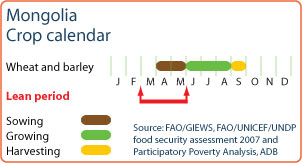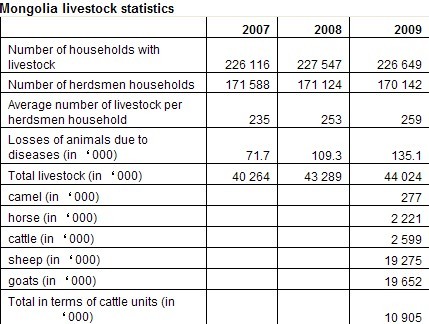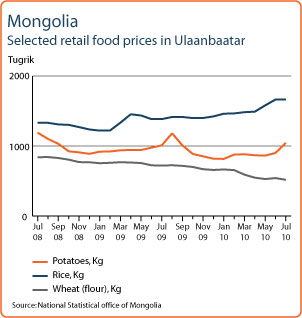Mongolia: Mongolia Agriculture Profile 2012
2012/03/20
Mongolia Agriculture Profile 2012
Reference Date: 23-May-2011
|
FOOD SECURITY SNAPSHOT
|
The revised 2010 wheat production at 346 000 tonnes is slightly below the record harvest of 2009 but still well above average
Planting of the 2011 summer crops, mainly wheat which began in April is currently nearing completion. The last crop was harvested in September 2010 and according to the official sources, the total wheat production is estimated at 346 000 tonnes. Although this is about 11 percent below the previous year’s record production, it is significantly above the previous five year average. The final estimate indicates that the reduction in production was mainly due to the yields which returned to normal levels, while the area under wheat was virtually unchanged. Total area planted to all crops in 2010 was up by 12 percent. Hence the area under other crops (such as other cereals, vegetables, and potatoes) more than doubled. This shift to crop cultivation is probably a reaction to the devastated livestock sector due to the adverse weather of 2009/10 winter season. The cereal import requirement for 2010/11 marketing year (Oct./Sept.) is estimated to increase slightly from the bumper crop year 2009/10. Wheat and rice are the two main cereals imported. The country’s harsh climate and very short growing season make it heavily dependent on imports for many food items.
Livestock numbers are slowly building back following the aftermath of the 2009 natural disaster
Livestock raising is the dominant agricultural activity and one of country’s key economic sectors. As seen from table below, the number of animals in 2010 stood at 32.7 million, indicating a reduction in the total head count by some 11 million, primarily a result of the unusually harsh weather. Breeding animal numbers have gone up from 7.0 million in April 2010 to 9.7 million by April 2011 but some ways to go to reach the level of over 11.2 million before the disaster. The livelihood and food security, of the affected half a million rural people are slowly being restored. However, the lingering effects of the livestock losses still weigh high on the livelihood of those affected and would take sustained effort to overcome. The country experienced a significant year-on-year economic growth of about 10 percent in April 2011.
Mongolia livestock statistics
|
|
|||
|
Source: National Statistical Office, Mongolia. Monthly Bulletin of Statistics, December 2010 |
|||
According to NSO, between 2005 and 2008 the country experienced a growth in GDP of 30 percent or an annual average rate of about 9 percent, mainly due to the favourable international prices of its export commodities, copper and gold in particular. GDP in 2009, however, is contracted by 1.6 percent over the previous year due to declining export prices of minerals.
Staple food prices have remained stable in recent months
The year-on-year consumer price inflation in February 2010 was 11 percent. Prices of wheat flour, the main food staple in the country, and rice have remained stable but at elevated levels in recent months. Bread prices, generally subsidised in the capital city Ulaanbaatar, are more stable and below the wheat flour prices. Beef and mutton prices in Ulaanbaatar capital city market follow the usual seasonal lows during October-December and highs during May-July. However the increases have been much more marked in 2010 and 2011 due to exceptional livestock losses following the Dzud earlier. Consequently, this summer prices are likely to remain higher than usual.
08/12/2010 Planted area for the current season is estimated to increase
 Planting of crops, mainly wheat, was completed in April and May. According to the official sources, total area planted this season is estimated to increase by 11 percent over the last year. Since wheat area increase is estimated at merely 2 percent, area under other crops (such as other cereals, vegetables, and potatoes), although very small in total, is estimated to more than double. This is probably a reaction to the devastated livestock sector due to the adverse weather of last winter season.
Planting of crops, mainly wheat, was completed in April and May. According to the official sources, total area planted this season is estimated to increase by 11 percent over the last year. Since wheat area increase is estimated at merely 2 percent, area under other crops (such as other cereals, vegetables, and potatoes), although very small in total, is estimated to more than double. This is probably a reaction to the devastated livestock sector due to the adverse weather of last winter season.
Livestock dependent households suffered serious loss due to severe winter condition, Dzud
 Food security, especially of the rural population, is adversely affected due to the Dzud weather conditions. According to official estimate the unusually harsh weather resulted in deaths of nearly six million heads out of a total of 44 million livestock in the country and adversely affected livelihood of some 500 000 people. Livestock raising is the dominant agricultural activity and one of country’s key economic sectors.
Food security, especially of the rural population, is adversely affected due to the Dzud weather conditions. According to official estimate the unusually harsh weather resulted in deaths of nearly six million heads out of a total of 44 million livestock in the country and adversely affected livelihood of some 500 000 people. Livestock raising is the dominant agricultural activity and one of country’s key economic sectors.

Total cereal harvest of 2009 officially estimated at a record level
 Harvesting of the 2009 wheat crop, virtually the only cereal produced in the country was completed in September. The official estimate of 2009 wheat harvest according to the National Statistical Office (NSO) of Mongolia at the end of December 2009 is 388 100 tonnes and total cereal harvest at 391 700 tonnes. This is more than double the drought affected output of 2008. Much of the wheat is produced under irrigation conditions. Hay production for 2009, on the other hand, is estimated by the Ministry of Agriculture at a poor level reducing fodder availability. As a result of the bumper harvest, imports of wheat would be reduced to some 70 000 tonnes in 2010 down from usual over 250 000 tonnes.
Harvesting of the 2009 wheat crop, virtually the only cereal produced in the country was completed in September. The official estimate of 2009 wheat harvest according to the National Statistical Office (NSO) of Mongolia at the end of December 2009 is 388 100 tonnes and total cereal harvest at 391 700 tonnes. This is more than double the drought affected output of 2008. Much of the wheat is produced under irrigation conditions. Hay production for 2009, on the other hand, is estimated by the Ministry of Agriculture at a poor level reducing fodder availability. As a result of the bumper harvest, imports of wheat would be reduced to some 70 000 tonnes in 2010 down from usual over 250 000 tonnes.
 According to NSO, between 2005 and 2008 the country experienced a growth in GDP of 30 percent or an annual average rate of about 9 percent, mainly due to the favourable international prices of its export commodities, copper and gold in particular. GDP in 2009, however, is expected to decline due to declining export prices of minerals.
According to NSO, between 2005 and 2008 the country experienced a growth in GDP of 30 percent or an annual average rate of about 9 percent, mainly due to the favourable international prices of its export commodities, copper and gold in particular. GDP in 2009, however, is expected to decline due to declining export prices of minerals.
Staple prices came down in 2009 but remain higher than the pre-crisis period
 Food security for large numbers of urban poor was significantly affected by the surging food prices in 2008 as the year-on-year inflation in the food subsector as a whole was 80.2 percent in June 2008. Prices of wheat flour, the main food staple in the country, have come down steadily since then but still remain higher than the pre-high food prices crisis period (June 2007). Bread prices, generally subsidised in the capital city Ulaanbaatar, are more stable and below the wheat flour prices, except since March 2010 when wheat flour price dropped. Rice prices on the other hand have remained high at the peak levels of mid-2008 international level and in local currency are at the highest level. Beef and mutton prices in Ulaanbaatar capital city market follow the usual seasonal lows during October-December and highs during May-July. However the increases have been much more marked this year due to exceptional livestock losses following the Dzud earlier. This summer prices are likely to remain higher for an extended period. The country’s harsh climate and very short growing season make it heavily dependent on imports for many food items.
Food security for large numbers of urban poor was significantly affected by the surging food prices in 2008 as the year-on-year inflation in the food subsector as a whole was 80.2 percent in June 2008. Prices of wheat flour, the main food staple in the country, have come down steadily since then but still remain higher than the pre-high food prices crisis period (June 2007). Bread prices, generally subsidised in the capital city Ulaanbaatar, are more stable and below the wheat flour prices, except since March 2010 when wheat flour price dropped. Rice prices on the other hand have remained high at the peak levels of mid-2008 international level and in local currency are at the highest level. Beef and mutton prices in Ulaanbaatar capital city market follow the usual seasonal lows during October-December and highs during May-July. However the increases have been much more marked this year due to exceptional livestock losses following the Dzud earlier. This summer prices are likely to remain higher for an extended period. The country’s harsh climate and very short growing season make it heavily dependent on imports for many food items.
- Mongolia News
-
- MONGOLIA: Battulga will receive the seal from outgoing President Tsakhiagiin Elbegdorj.
- MONGOLIA: Mongolia’s mighty military diplomacy
- CHINA: Saving face on the Korean Peninsula
- AFGHANISTAN: Higher earning Why a university degree is worth more in some countries than others
- CHINA: Asian Markets Retreat After Oil Prices Fall Again
- AFGHANISTAN: Global growth will be disappointing in 2016: IMF's Lagarde
- Trending Articles
-
- QATAR: Qatar Airways transit business in jeopardy
- EGYPT: Egypt foreign reserves at highest since 2011 uprising
- QATAR: Qatar plans to boost gas production by 30%
- EGYPT: Egypt announces new sharp increase in fuel prices
- SAUDI ARABIA: Saudi stock market bullish on new heir
- MOROCCO: Morocco delays currency reform amid speculation









